This article contains spoilers for Axiom Verge and Axiom Verge 2. We go hard on Axiom Verge, but Axiom Verge 2 spoilers are considered to be “light”. That said, if you want to go into either game “clean”, you have been warned…
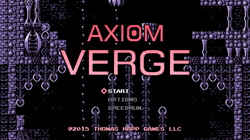 Fear. Isolation. Losing your very sense of self. Learning that you may be becoming a threat to yourself and others. Having an unstoppable magic gun that allows you to function as a God.
Fear. Isolation. Losing your very sense of self. Learning that you may be becoming a threat to yourself and others. Having an unstoppable magic gun that allows you to function as a God.
Which one of these doesn’t fit?
Axiom Verge is easily one of the best metroidvania titles of the last decade. For that matter, it is one of the best games, period, of all time. But its place in time is important, as much of Axiom Verge relies on an understanding from both the author and the audience of many games that have come before. Metroid was amazing and arguably kicked off the metroidvania (hey, it’s right there in the title) genre, but it was also a glitchy mess. Mario had one minus world, Metroid had an entire planet’s worth of areas that could be discovered if you jumped off of a doorway the “wrong” way. Axiom Verge uses this concept to create “intended glitches” in the form of breach blocks, unique areas, and even enemies that all rely on the visual shorthand of “oh, this area is fudged”. It takes what was already a pretty great planet explore ‘em up and transforms it into something simultaneously new and nostalgic. Axiom Verge is not the only game to utilize “glitches” and the shorthand of the medium itself to create memorable moments, but it might be the game that does so the most seamlessly and wittily. If Axiom Verge was just a dedicated metroidvania, it would be excellent, but its own unique flavor elevates it to something extraordinary.
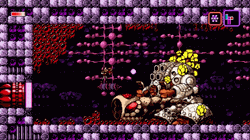 And, hey, as a special bonus, Axiom Verge has an interesting plot, too. You are Trace, a friendly scientist that was crippled in a lab accident a few years back. But he’s fine now! Because he was revived on an alien planet for the express purpose of committing the most complicated suicide known to man. “Your” Trace is a clone of a young man that would eventually become an interdimensional despot that conquered an entire planet and is at least partially responsible for releasing a plague that is wholly responsible for a genocide or two. Young Trace must now find and stop Old Trace, aka Athetos, and learn along the way that his own allies, the Rusalki, are maybe not the most reliable giant mechanoids in the omniverse. It creates tension from all sides of this tale, and the fact that the Rusalki are fond of reminding you that they can literally kill you at any time with a thought does not exactly engender a trust that you are on the right side of this conflict. Like many of the best metroidvania titles available, Axiom Verge has created a world where you feel alone not just because you’re stuck with only jumpy bugs for company, but because anything that can communicate in something other than screams is likely trying to kill you, too.
And, hey, as a special bonus, Axiom Verge has an interesting plot, too. You are Trace, a friendly scientist that was crippled in a lab accident a few years back. But he’s fine now! Because he was revived on an alien planet for the express purpose of committing the most complicated suicide known to man. “Your” Trace is a clone of a young man that would eventually become an interdimensional despot that conquered an entire planet and is at least partially responsible for releasing a plague that is wholly responsible for a genocide or two. Young Trace must now find and stop Old Trace, aka Athetos, and learn along the way that his own allies, the Rusalki, are maybe not the most reliable giant mechanoids in the omniverse. It creates tension from all sides of this tale, and the fact that the Rusalki are fond of reminding you that they can literally kill you at any time with a thought does not exactly engender a trust that you are on the right side of this conflict. Like many of the best metroidvania titles available, Axiom Verge has created a world where you feel alone not just because you’re stuck with only jumpy bugs for company, but because anything that can communicate in something other than screams is likely trying to kill you, too.
Except it is a little undercut by the fact that Axiom Verge seems to transform Trace into a friggin’ god.
Look, maybe I’m confused, and that is the point here. Trace is destined to become an unstoppable monster of a man, and maybe it was the Axiom Disrupter that got him there. Maybe that is the purpose of the exercise for Trace: absolute power corrupts, and absolute gun grants absolute power. But… that does not seem to be reinforced by Trace’s circumstances. When Trace wins the day, he is immediately betrayed by his Rusalki friend, and can only helplessly watch as promises are broken. Throughout the adventure, Trace attempts to show autonomy by resisting the violent nature of being a videogame protagonist, but, save one boss that forgot to lock the doors, Trace is forced to murder every mutant between his pod and freedom. There is even one “boss” that is just a soggy mess of altruistic protoplasm, but it’s gotta go, because it is in the way of a powerup. Over and over again, it is reinforced that Trace has no control over his own existence.
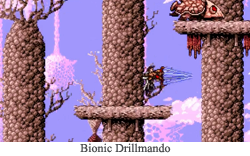 But Trace has seemingly unlimited control over everything else in his life. Trace starts with a basic peashooter, but it quickly graduates to something that can fire “bullets” that handle any situation. Somewhere in there, he acquires a drone that allows for nigh-invincible exploration (drones can die, but Trace doesn’t suffer any consequences), a grappling hook that improves traversal immensely, and something that could best be described as a “glitch gun”. That final item is particularly amazing, as even the most powerful enemy can be blasted through a wall until it has been glitched into a state of extreme vulnerability. And just when that glitch gun loses its luster, Trace acquires screen-impacting glitch bombs. And that is right about when Trace gains the ability to teleport to his own drones, so he can toss a lil’ buddy down a corridor, dodge every monster in the area, and then teleport to safety. Want to be the pacifist Trace always claims to be? Just drone around town and have a fun time!
But Trace has seemingly unlimited control over everything else in his life. Trace starts with a basic peashooter, but it quickly graduates to something that can fire “bullets” that handle any situation. Somewhere in there, he acquires a drone that allows for nigh-invincible exploration (drones can die, but Trace doesn’t suffer any consequences), a grappling hook that improves traversal immensely, and something that could best be described as a “glitch gun”. That final item is particularly amazing, as even the most powerful enemy can be blasted through a wall until it has been glitched into a state of extreme vulnerability. And just when that glitch gun loses its luster, Trace acquires screen-impacting glitch bombs. And that is right about when Trace gains the ability to teleport to his own drones, so he can toss a lil’ buddy down a corridor, dodge every monster in the area, and then teleport to safety. Want to be the pacifist Trace always claims to be? Just drone around town and have a fun time!
And, ultimately, that is the problem. The reason Axiom Verge is great is, ultimately, because it is fun. And you don’t get to be fun by having a severely limited protagonist. It is fun to screw attack Zebes as Samus Aran, and it is fun to glitch, trick, and obliterate your mindless opponents in Axiom Verge. It is a blast to see a final area that initially seems daunting, but then gradually discover how to use your myriad of abilities to navigate the dangers without a single scratch. There is nothing more enjoyable than solving a series of logic puzzles, earning a flame thrower for your efforts, and then barbequing every problem you could ever encounter. Solving problems through variable violence might not be Trace’s bag, but it is irrefutably the most fun to be had on Sudra.
So is it even possible to have fun in a metroidvania without becoming ridiculously empowered and/or presenting a series of challenges that tax those ridiculous powers? Can the protagonist of a fun metroidvania be anything but a killing machine?
Gee, pretty convenient Axiom Verge 2 is right there.
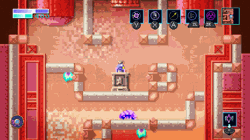 In a lot of ways, Axiom Verge 2 repeats Axiom Verge beats. Indra is a scientist-CEO that knows a thing or two about computer equipment, but not necessarily how to defeat a mecha-bug. She will get there, though, with the help of a number of powerups that upgrade her offensive and acrobatic abilities. And the ability to summon and/or be a drone, which is apparently a recurring thing! Dimension hopping will be involved, subduing someone that is maybe yourself is certainly on the menu, and, in the end, our heroine is going to toe the line between life and death as something wholly “other” from her original self. Every Axiom Verge protagonist dies at least once, apparently. If you took Trace through his metroidvania world, you’ll be perfectly comfortable with Indra bumping around a dimension or two in Axiom Verge 2. It’s a sequel! You’re back for more of the same, so there is a lot of “the same” here.
In a lot of ways, Axiom Verge 2 repeats Axiom Verge beats. Indra is a scientist-CEO that knows a thing or two about computer equipment, but not necessarily how to defeat a mecha-bug. She will get there, though, with the help of a number of powerups that upgrade her offensive and acrobatic abilities. And the ability to summon and/or be a drone, which is apparently a recurring thing! Dimension hopping will be involved, subduing someone that is maybe yourself is certainly on the menu, and, in the end, our heroine is going to toe the line between life and death as something wholly “other” from her original self. Every Axiom Verge protagonist dies at least once, apparently. If you took Trace through his metroidvania world, you’ll be perfectly comfortable with Indra bumping around a dimension or two in Axiom Verge 2. It’s a sequel! You’re back for more of the same, so there is a lot of “the same” here.
But where Axiom Verge 2 deviates wildly from its predecessor makes all the difference. Indra does not receive a magical gun at the start of her journey, she obtains something little more fantastical than a pickaxe. When Indra inevitably gains her first sufficiently-advanced-technology-is-indistinguishable-from-magic upgrade shortly thereafter, she gains exactly zero additional offensive options. From there, she gets… a boomerang. It worked for Link, right? Well, it barely works here, and, while Indra gains greater and greater abilities as her quest proceeds, she never comes close to gaining the same destructive strength as Trace. The shock droids of the first area are still just as likely to incapacitate Indra at the end of her adventure as the beginning, and the upgraded “boss” monsters… Well… probably best if you just keep walking, Indra. Ain’t nothin’ you can do to that mobile tank…
But, much more than in Axiom Verge, in Axiom Verge 2, that seems to be the whole point.
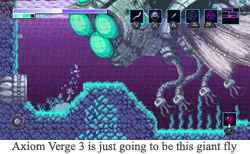 There is not a single boss in Axiom Verge that must be permanently killed. There are (by my count) two bosses you must actively/temporarily incapacitate, but every other opponent can be ignored. In fact, were it not for the generally claustrophobic halls of the Breach Dimension, it would likely be tremendously easier to beat Axiom Verge 2 by not attacking a single soul. Do you get rewards for smashing robots or felling alien fauna? A health power up here or there is your only prize, as any form of “leveling” is almost entirely based on exploration (there are, like, four upgrades out of a hundred you get from actual violence). Beyond that, you are never chastised for running, and a number of the biggest, scariest monsters will be content to lumber around the same room for eternity if you do not fell them. And why would you? For outright attacks, you have, at best, a cool sword. Ever try to take down a tree with a machete? And the tree is also trying to eat you? Well, it’s like that, so why would you put yourself in such danger? Just walk away, Indra!
There is not a single boss in Axiom Verge that must be permanently killed. There are (by my count) two bosses you must actively/temporarily incapacitate, but every other opponent can be ignored. In fact, were it not for the generally claustrophobic halls of the Breach Dimension, it would likely be tremendously easier to beat Axiom Verge 2 by not attacking a single soul. Do you get rewards for smashing robots or felling alien fauna? A health power up here or there is your only prize, as any form of “leveling” is almost entirely based on exploration (there are, like, four upgrades out of a hundred you get from actual violence). Beyond that, you are never chastised for running, and a number of the biggest, scariest monsters will be content to lumber around the same room for eternity if you do not fell them. And why would you? For outright attacks, you have, at best, a cool sword. Ever try to take down a tree with a machete? And the tree is also trying to eat you? Well, it’s like that, so why would you put yourself in such danger? Just walk away, Indra!
Trace may have claimed to be something like a peacemaker, but he literally could not leave his first room without letting his weapon rip. Indra, meanwhile, may gain the (limited) power to be a thinking bomb, but she lives in a world where it is possible to only use that ability to open passageways. She gains similar glitch/hacking tech, but can use it exclusively to have enemies drop health powerups. Indra never becomes godlike in her abilities, and that is a good thing, because, in an exploration-based world, she actually has incentive to explore. Find those passageways! Discover all the ways a breach-attractor can get you out of trouble! Do it all for the possibility of not getting destroyed by a leering space head. You’ll thank me later!
And… that feels weird.
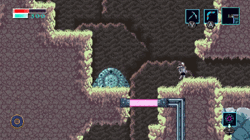 In fact, it repeatedly feels wrong. I want to be gameplay-Trace, not plot-Trace. I want to roll around the planet with enough power to conquer said planet. I want the local rabble to fear my strength, because, dammit it feels good to be wholly in power. Hey, droid jet that is trying to kill me? I will hack you, embarrass you, and then kill you! Because I’m the best! But Indra can’t be the best. No matter how many upgrades you find on her world, she will never come close to being half as strong as Nintendo’s intergalactic bounty hunter. Indra is never going to be able to solve her problems with weaponry, because she will never find the weapons that would allow that. So, as a player, I am disappointed in her lack of laser boomerangs.
In fact, it repeatedly feels wrong. I want to be gameplay-Trace, not plot-Trace. I want to roll around the planet with enough power to conquer said planet. I want the local rabble to fear my strength, because, dammit it feels good to be wholly in power. Hey, droid jet that is trying to kill me? I will hack you, embarrass you, and then kill you! Because I’m the best! But Indra can’t be the best. No matter how many upgrades you find on her world, she will never come close to being half as strong as Nintendo’s intergalactic bounty hunter. Indra is never going to be able to solve her problems with weaponry, because she will never find the weapons that would allow that. So, as a player, I am disappointed in her lack of laser boomerangs.
Yet, Axiom Verge 2 still winds up being one of the best games I have ever played. Axiom Verge 2 may actually be one of the best examples of gameplay-plot synergy out there. I genuinely believe Samus Aran is capable of being vulnerable around the space dragon that ate her parents… but it is harder to believe after I have seen her explode entire planets. Meanwhile, Indra is a mother, scientist, and CEO, and I believe this is how someone from those circumstances would become a powerful robot lady. Is she vastly changed by the end of her quest? Of course. But she also is not vaporizing space monsters with a cannon capable of melting mountains. She might be able to morph into a drone, but that doesn’t give her a leg up on swinging a sword. While this author doesn’t know anyone that became a cyborg while exploring another dimension, that progression seems right. Axiom Verge 2 might turn the typical Metroid paradigm on its head, but it feels like it gets there by an honest path.
But this is a videogame website, so we have to ask the question: which is better? We have two vaguely mundane protagonists, but only one wielding a god-gun. And which makes for a better game? Well, I am a wiener, so I am going to claim both. I want Axiom Verge, because I like mowing down monsters. But Axiom Verge 2 felt more genuine and thoughtful, so I suppose I can give up raw power for authenticity. Axiom Verge 2 initially disappointed me by not being Axiom Verge, but it seems like a game I might think back on more often than its progenitor.
… Or I’ll just grab a new weapon that doubles as a grappling hook, and forget those “feelings” things ever happened…
FGC #616 Axiom Verge & Axiom Verge 2
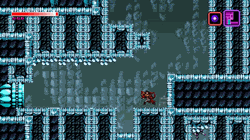 System: Axiom Verge was released on everything relevant at its release (PS4, PC, WiiU, Xbox One, the friggen’ Vita), and a few extra systems since (Nintendo Switch). Axiom Verge 2 is currently on Switch, PC, and PS4, and I think a Playstation 5 version is incoming. Or it is just the PS4 version? Who the heck knows.
System: Axiom Verge was released on everything relevant at its release (PS4, PC, WiiU, Xbox One, the friggen’ Vita), and a few extra systems since (Nintendo Switch). Axiom Verge 2 is currently on Switch, PC, and PS4, and I think a Playstation 5 version is incoming. Or it is just the PS4 version? Who the heck knows.- Number of players: Speed running against other players is kind of like competitive multiplayer, but it is primarily single player.
- Just play the gig, man: The music in both games is incredible. And so is the pixel art, level design, and general plotting. But the music is really good! … Like everything else. Dammit.
- Alone in the Dark: Okay, maybe my main “disappointment” with Axiom Verge 2 is that it uses dynamic lighting to create “dark” areas in early parts of the game. While it makes for an excellent, moody setting, I abhor any malady in a videogame that hampers the player’s sight. This also applies to status effects in Kingdom Hearts PSP titles, and any time Mario encounters a “dark” ghost house. I am having flashbacks to my college, tic-tac-sized TV screen. It’s traumatic!
- A matter of skill: Also, I do not care for allocating “skill points” in Axiom Verge 2. This is a great way to take hold of your unique playstyle or something, but it mostly just gives me choice paralysis, and I never upgrade anything, because I assume I am going to get some awesome ability later in the game, and not have the scratch to buy its cooler version. And that happens! When you get a flying powerup super late in the game! Please go back to just dropping missile containers, please.
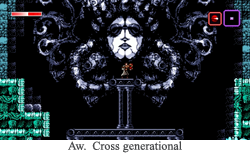 Story Time (super-duper spoilers): It is possible and very probable that the big connection between Axiom Verge and Axiom Verge 2 is that Indra of AV2 eventually becomes Ophelia the giant robot lady of Axiom Verge, thus making AV2 a prequel to Trace’s adventures. And there are a lot of little lore bits, too, like how your breach buddy can accidentally infect humans, and transform them into Axiom Verge bosses. Or it is all a bunch of coincidences in an infinite multiverse, and we should really just relax.
Story Time (super-duper spoilers): It is possible and very probable that the big connection between Axiom Verge and Axiom Verge 2 is that Indra of AV2 eventually becomes Ophelia the giant robot lady of Axiom Verge, thus making AV2 a prequel to Trace’s adventures. And there are a lot of little lore bits, too, like how your breach buddy can accidentally infect humans, and transform them into Axiom Verge bosses. Or it is all a bunch of coincidences in an infinite multiverse, and we should really just relax.- Favorite boss (first game): Never going to forget that Kraid wannabe that was peaking out of an acid pool in Axiom Verge. He might not have moved much, but he certainly was tall. And, sometimes, tall is all you need.
- Favorite boss (second game): The “always revive every time” boss battle with yourself seemed to initially tease that you were both invincible, but having a respawn point right there added a special level of futility to the proceedings. Violence is not the answer! When everyone is immortal, at least…
- Did you know? Okay, nothing in Axiom Verge 2 comes close to the hallucination sequence in Axiom Verge, so it is hard to admit that one game isn’t better than the other.
- Would I play again: Yes. Duh. I was excited to have an excuse to play Axiom Verge again in time for Axiom Verge 2, and I will likely still think the same in five years when Axiom Verge 3 rolls around. Good stuff!
What’s next? Random ROB has chosen… Astro Boy: Omega Factor for the Gameboy Advance! Get ready for the other little metal boy on the block! Please look forward to it!
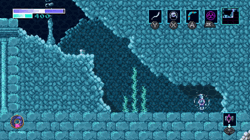
Just go ahead and utilize that doomsday weapon for funsies